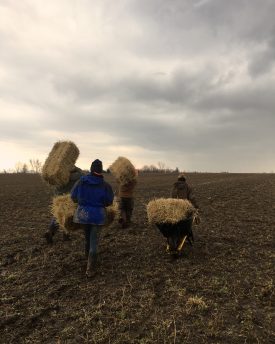Research Projects
STAMP

Project Location and Purpose
[Top right image: UB Survey crew members transport hay to cover and preserve test units before a big frost. The winter of 2017 was warmer than usual, and the crew was able to work throughout most of the early months.]
The Science, Technology, Advanced Manufacturing Park (STAMP) is a large, complex compliance archaeology project conducted by UB Archaeological Survey for CC Environmental & Planning. The future industrial manufacturing park is potentially a 1400 acre project in the town of Alabama, New York. Our work was designed to locate all archaeological sites that may be impacted by the proposed project and develop a management plan for avoiding sites where possible and excavating sites in areas slated for direct impacts.
Methods
In accordance with State and Federal regulations, a Phase I survey was conducted from 2011-2015. Through a combination of shovel test pits (STPs), systematic surface survey of plowed fields, and archival research a total of twenty-seven sites were found. In the fall of 2016 and winter of 2017, the Phase II site examination excavations were conducted. This phase of research determined which sites are eligible for the State and National Register of Historic Places at therefore which need full mitigation before the construction of the park.
UB Archaeological Survey has conducted a wide variety of testing methods across the entirety of the STAMP project area. We have identified sites from the Early Archaic, Late Archaic, Early Woodland and Middle Woodland periods as well as farmsteads and residences from the 19th century. It is interesting to note the lack of any late Woodland/Iroquoian sites in this locale. During the Phase II work test units were dug at all sites to be impacted by the building of the park, with deep testing performed as possible via hand excavations. Note that only about half of the sites identified have sufficient integrity and research potential to necessitate Phase III mitigation excavations, whereas the others are very small sites with very low artifact density suggesting numerous ephemeral uses of the local landscape throughout a broad duration of time.
- Crew members Leah Glenn and Salvatore Sciascia set up a 1x1m test unit.
- Crew chief Dr. Kathryn Whalen checks over paperwork for Site 19.
- Veteran archaeology dog, Tae, and crew member Ashlee Hart, set up paperwork on a particularly warm winter work day.
(Full sized images open in new window, click to enhance and view features!)
Due to the close proximity of the Tonawanda Seneca Nation reservation, adjacent to our project area to the west, all archaeological field work for this project has been supervised by a monitor from the Tonawanda Seneca Nation.
Results
One of the interesting aspects of this project area is the number of different micro-environments identified, and their potential association with different types of lithic technology. Variation in artifact assemblages found in different environmental areas has the potential to help tell the story of how the landscape has changed over time, and address questions of how people have changed or not changed in response. Lithic technology is just one mechanism for dealing with the environment. Using site data that spans thousands of years may allow us to study how changes in this technology reflect large-scale shifts in society and the environment.
Specifically, there is an abundance of research potential in the comparison of Archaic versus the Woodland sites in the project area. The Archaic/Woodland transition is a period in which there appears to have been dramatic linked cultural and environmental change. On either side of this transition, smaller competing Archaic groups transitioned to, or developed into a larger interaction network. The Meadowood interaction sphere covered thousands of miles, and spread a variety of exotic and well-recognized trade goods, unique objects of great social significance, perhaps with a worldview that united people across the Northeast. This view is supported by lithic analysis results and land use patterns apparent in this project area. Future Phase III data will help us refine this picture and better describe how people were living on the landscape at different time periods, and how that shaped their everyday lives.
The 19th century sites in the project area are also of special interest because the land was once part of the Tonawanda Seneca Nation Reservation and such sites may represent the homesteads of Seneca peoples. These properties have the potential to tell us about an important and tragic time in Western New York’s history as large scale social changes were forced on Indian Nations of the 19th century.










